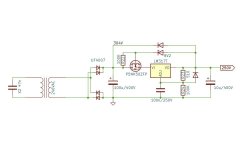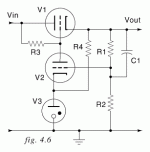Some developers of tube amps claim, that for HV power supplies (for anode voltage) only passive filtering (maybe with zeners for slightly shunt regulation) are ensures the best possible sound quality resp best sonic performance. I. e. only one or two inductors and a chain consist of several RC filters. From my experience this is right, as long only top quality elcaps are in use and in the last RC filter additional a MKP version with 50-100uF.
An example are several pre-amp devices from Klimo.
Schematics of first five attached images show such passive versions - i. e. without serial or parallel voltage regulation (except one version in inage 2 with the zeners).
The later attachments show schematics of serial regulators in several variations.
At first glance the benefit of serial and parallel regulators are a very stable voltage, that is additional adjustable in a wide range.
But is it in real live really a fact, that a stable anode voltage provide a better audio than a passive filtered voltage ?
In general I don't think so.
Thank you for comments.
P.S.: some URL's:
HV Serial Regulator
https://tubecad.com/2021/10/blog0546.htm
https://pearl-hifi.com/06_Lit_Archive/14_Books_Tech_Papers/Broskie_John/HV_Regulator_OP27_IRF820.pdf
https://www.bartola.co.uk/valves/2015/01/10/popping-the-shunt-voltage-regulators-clogs/
https://www.bartola.co.uk/valves/2012/07/15/new-ht-bench-power-supply-600v/
https://www.bartola.co.uk/valves/page/2/
https://www.tubecad.com/2021/10/blog0547.htm
https://www.tubecad.com/2020/02/blog0493.htm
https://www.tubecad.com/2021/09/blog0545.htm
A commodity-based HV regulator: FlexHV
High Voltage Jung Regulator
HV Parallel (Shunt-) Regulator
https://www.tubecad.com/2006/11/blog0087.htm
https://www.tubecad.com/2021/11/blog0548.htm
https://www.tubecad.com/2021/01/blog0527.htm
https://www.tubecad.com/2007/06/blog0109.htm
Very low parts count shunt regulator
Passive Filter (RC/LRC)
https://www.jogis-roehrenbude.de/Leserbriefe/Carsten-RIAA/Carsten-RIAA.htm
https://www.audionist.de/2015/11/27/netzteil-fuer-einen-roehrenverstaerker-2/
https://www.turneraudio.com.au/audiofilterchokes.html
https://www.turneraudio.com.au/audiofilterchokes-page2.html
Choke ratings and resistor values in choke input supply?
TUBE AMP POWER SUPPLIES (basics to all supply variants)
https://www.turneraudio.com.au/powersupplies.html
croft series 7 HV regulator
https://www.tubecad.com/2021/10/blog0547.htm
An example are several pre-amp devices from Klimo.
Schematics of first five attached images show such passive versions - i. e. without serial or parallel voltage regulation (except one version in inage 2 with the zeners).
The later attachments show schematics of serial regulators in several variations.
At first glance the benefit of serial and parallel regulators are a very stable voltage, that is additional adjustable in a wide range.
But is it in real live really a fact, that a stable anode voltage provide a better audio than a passive filtered voltage ?
In general I don't think so.
Thank you for comments.
P.S.: some URL's:
HV Serial Regulator
https://tubecad.com/2021/10/blog0546.htm
https://pearl-hifi.com/06_Lit_Archive/14_Books_Tech_Papers/Broskie_John/HV_Regulator_OP27_IRF820.pdf
https://www.bartola.co.uk/valves/2015/01/10/popping-the-shunt-voltage-regulators-clogs/
https://www.bartola.co.uk/valves/2012/07/15/new-ht-bench-power-supply-600v/
https://www.bartola.co.uk/valves/page/2/
https://www.tubecad.com/2021/10/blog0547.htm
https://www.tubecad.com/2020/02/blog0493.htm
https://www.tubecad.com/2021/09/blog0545.htm
A commodity-based HV regulator: FlexHV
High Voltage Jung Regulator
HV Parallel (Shunt-) Regulator
https://www.tubecad.com/2006/11/blog0087.htm
https://www.tubecad.com/2021/11/blog0548.htm
https://www.tubecad.com/2021/01/blog0527.htm
https://www.tubecad.com/2007/06/blog0109.htm
Very low parts count shunt regulator
Passive Filter (RC/LRC)
https://www.jogis-roehrenbude.de/Leserbriefe/Carsten-RIAA/Carsten-RIAA.htm
https://www.audionist.de/2015/11/27/netzteil-fuer-einen-roehrenverstaerker-2/
https://www.turneraudio.com.au/audiofilterchokes.html
https://www.turneraudio.com.au/audiofilterchokes-page2.html
Choke ratings and resistor values in choke input supply?
TUBE AMP POWER SUPPLIES (basics to all supply variants)
https://www.turneraudio.com.au/powersupplies.html
croft series 7 HV regulator
https://www.tubecad.com/2021/10/blog0547.htm
Attachments
-
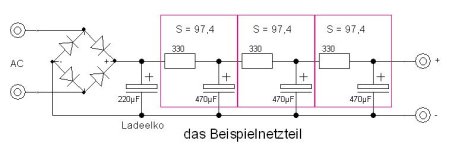 HV passive filtered power supply.jpg27.6 KB · Views: 133
HV passive filtered power supply.jpg27.6 KB · Views: 133 -
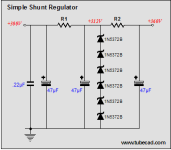 HV passive filtered with shunt zeners.png7.1 KB · Views: 118
HV passive filtered with shunt zeners.png7.1 KB · Views: 118 -
 HV passive filtered power supply EZ81.png25.8 KB · Views: 125
HV passive filtered power supply EZ81.png25.8 KB · Views: 125 -
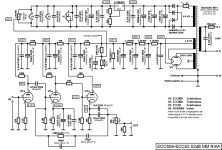 HV passive filtered 287VAC for EAR834.png61.8 KB · Views: 119
HV passive filtered 287VAC for EAR834.png61.8 KB · Views: 119 -
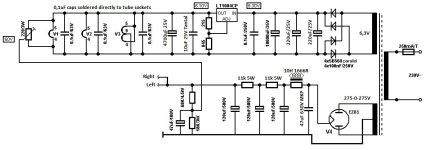 HV passive filtered power supply EZ81 275VDC.jpg54.3 KB · Views: 120
HV passive filtered power supply EZ81 275VDC.jpg54.3 KB · Views: 120 -
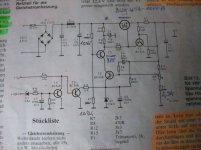 HV 275VAC BUK456-1000 serial regulator ELRAD.jpg556.5 KB · Views: 122
HV 275VAC BUK456-1000 serial regulator ELRAD.jpg556.5 KB · Views: 122 -
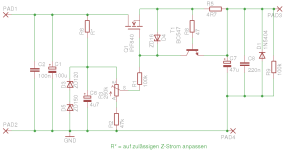 HV 255VAC IRF840 ser. regulator.png18.7 KB · Views: 114
HV 255VAC IRF840 ser. regulator.png18.7 KB · Views: 114 -
 HV 330VDC Series Regulator OP-AMP+IRF840.png27.5 KB · Views: 119
HV 330VDC Series Regulator OP-AMP+IRF840.png27.5 KB · Views: 119 -
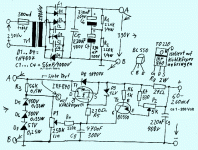 HV 250VAC IRF840 ser. regulator.gif30.3 KB · Views: 119
HV 250VAC IRF840 ser. regulator.gif30.3 KB · Views: 119 -
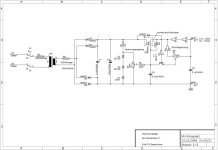 HV 255VAC IRF840 serial regulator.jpg38.5 KB · Views: 118
HV 255VAC IRF840 serial regulator.jpg38.5 KB · Views: 118 -
 HV 300VDC 2SK3564 serial regulator.jpg63.3 KB · Views: 121
HV 300VDC 2SK3564 serial regulator.jpg63.3 KB · Views: 121 -
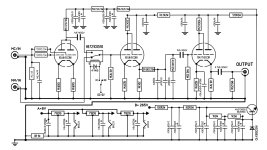 HV 265VDC MJE13005 serial regulator for klimo-phono.jpg172.9 KB · Views: 115
HV 265VDC MJE13005 serial regulator for klimo-phono.jpg172.9 KB · Views: 115 -
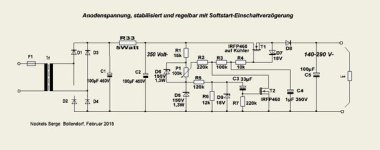 HV 140-290VDC IRFP460 serial regulator.jpg21.5 KB · Views: 111
HV 140-290VDC IRFP460 serial regulator.jpg21.5 KB · Views: 111 -
 HV 244VDC 2xMJE13007 Darl. serial regulator.gif12.1 KB · Views: 105
HV 244VDC 2xMJE13007 Darl. serial regulator.gif12.1 KB · Views: 105 -
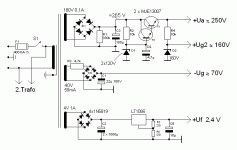 HV 250VDC 2xMJE13007 Darl. serial regulator.gif9.2 KB · Views: 117
HV 250VDC 2xMJE13007 Darl. serial regulator.gif9.2 KB · Views: 117
Last edited:
Image 1-3 show some serial regulator schematics like used in the Croft tube pre- and power amps series 7 (image 4 is the topology from the croft series 7 itself.
Are there a colloquial naming for this kind of serial regulation ?
Thank you for an advice.
Are there a colloquial naming for this kind of serial regulation ?
Thank you for an advice.
Attachments
-
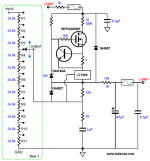 HV LM317 o. LT1085+IRFPG30 Serial Regulator5.png35.7 KB · Views: 97
HV LM317 o. LT1085+IRFPG30 Serial Regulator5.png35.7 KB · Views: 97 -
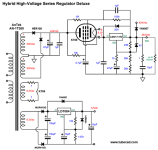 HV LM317+KT88 263VAC-serial Regulator Deluxe 1.png37.5 KB · Views: 97
HV LM317+KT88 263VAC-serial Regulator Deluxe 1.png37.5 KB · Views: 97 -
 HV LM317+BUZ50B 205V_100mA voltage regulator - microcontroller.net Stabiröhrenschaltung erset...webp24.2 KB · Views: 91
HV LM317+BUZ50B 205V_100mA voltage regulator - microcontroller.net Stabiröhrenschaltung erset...webp24.2 KB · Views: 91 -
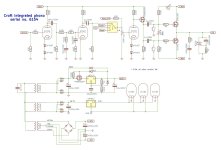 HV LM317+MOSFET 251VDC ser.reg.Croft ser. 7.jpg192.4 KB · Views: 93
HV LM317+MOSFET 251VDC ser.reg.Croft ser. 7.jpg192.4 KB · Views: 93
Hi!
HV power supply only provides you the GND and +V.
Ideally, +V should be a constant fixed value and should not interfer with sound quality.
Some questions just to provocate the discussion before discussing the technology.
1) What is the influence of +V variations (slow related to regulation and fast such as ripple and/or noise) in the output amp signal?
2) Real world is not ideal, so what should be the minimum specs of +V (regulation, ripple, noise etc)?
3) If the power supply is in a "black box", how do you detect how the +V was generated? Would it matter? I could make some tests to see if I "like" the +V or not and would infer more or less about the circuit inside the box..
With these questions well answered, then we can move to the discussion about the technology to produce the +V to get the adequate and best sonic +V.
HV power supply only provides you the GND and +V.
Ideally, +V should be a constant fixed value and should not interfer with sound quality.
Some questions just to provocate the discussion before discussing the technology.
1) What is the influence of +V variations (slow related to regulation and fast such as ripple and/or noise) in the output amp signal?
2) Real world is not ideal, so what should be the minimum specs of +V (regulation, ripple, noise etc)?
3) If the power supply is in a "black box", how do you detect how the +V was generated? Would it matter? I could make some tests to see if I "like" the +V or not and would infer more or less about the circuit inside the box..
With these questions well answered, then we can move to the discussion about the technology to produce the +V to get the adequate and best sonic +V.
Some developers of tube amps claim, that for HV power supplies (for anode voltage) only passive filtering (maybe with zeners for slightly shunt regulation) are ensures the best possible sound quality resp best sonic performance. I. e. only one or two inductors and a chain consist of several RC filters.
What is ...YOUR... definition of ''best possible sound quality'' ? Does any of the examples create that? How do you know?
I used to be in the regulator camp, I used Maida regulators for anything critical.
When I was prototyping my latest preamp (I was very happy about the sound) I got curious how an unregulated C-L-C would compare.
I prefered it! The regulated supply sounded restricted. Unregulated was more dynamic, lively, sharper stereo image.
Just my $0.02
When I was prototyping my latest preamp (I was very happy about the sound) I got curious how an unregulated C-L-C would compare.
I prefered it! The regulated supply sounded restricted. Unregulated was more dynamic, lively, sharper stereo image.
Just my $0.02
yes, good advice (AN007335, National Semiconductor Linear Brief 47, Michael Maida, March 1980)Maida style regulator...?
An interesting approach to use low voltage integrated regulators for regulated high voltage power supplies.
https://www.ti.com/lit/an/snva583/snva583.pdf
https://www.ti.com/lit/an/snoa648/snoa648.pdf
additional URLs to Maida style HV regulator
http://www.pmillett.com/HV_reg.html
https://attackllama.com/pages/hardware/high-voltage-filter
LM317/TL431 High Voltage Floating Regulator
21st Century Maida Regulator
High Voltage Regulators (Maida or zener)
Maida regulator
21st Century Maida regulator doesn't regulate heavy load
Maybe it is possible to make things better in the version used in croft series 7.
Attachments
exact this observations I had note in general when I compare unregulated against regulated power supplies wich I had make several times while repair services (BTW - both in tube and solid state versions). Because the main electrolytic capacity in most cases is located in front of the regulator instead after the regulator one will get the unwanted effect, that the regulator is partly in the signal pad (slow voltage variations, which occurs when only LRC parts for filtering are in use, seems to be no disadvantages regarded the sonic performance).I used to be in the regulator camp, I used Maida regulators for anything critical.
When I was prototyping my latest preamp (I was very happy about the sound) I got curious how an unregulated C-L-C would compare.
I prefered it! The regulated supply sounded restricted. Unregulated was more dynamic, lively, sharper stereo image.
Just my $0.02
I remember long time ago (80s) Klimo explained during a demonstration of his tube amp devices (with outdoor power supplies) at a trade fair (High End, Gravenbruch Kempinski/Ffm), that only with a passive filtering the very good sound results, which were clearly comprehensible on this day, could be achieved.
P.S.: (reply post #5) ''best possible sound quality'' means for me, a maximum authenticity, i.e. the presentation of the recording on a listening test session gives the illusion that it is taking place "LIVE"
Last edited:
But is it in real live really a fact, that a stable anode voltage provide a better audio than a passive filtered voltage ?
In general I don't think so.
Over the years i have changed my opinion on this a few times. In the 80-ies i couldn't stand regulation in tube circuits; it was either batteries (MC step ups) or multi stage RC filtering. The chokes i could get at the time were really horrible and not an alternative.
Later on there were choke inputs + shunt regs. The choke input being pretty much non negotiable with mercury rectifiers.
Today i have no rules at all about power delivery, both in SS and in tube circuits.
Some circuits in some systems sound better with minimal or no regulation, others are just fine with 317/337 regulators and in some cases a shunt regulator is a must. There is no universally best sounding solution.
Looks like i may be getting away from chokes as these have the tendency to slow things down. Used to love them 10yrs ago. Perhaps hearing and taste change a lot over a lifetime. Most of my PSs are half wave rectified so that may also be a consideration when choosing the type of regulation.
Ultimately, I believe that – when series regulators are in use – the sonic influences arise from the fact that the filtering capacitor behind the series regulator is usually too small, and thus the signature of the series regulator is more or less evident in the sound perception.
This is the great advantage of parallel resp. shunt regulators and passive filters; here, this capacitor, this is between pos. and neg. rail of the actually amp resp. preamp unit, can be made as large as desired with lowest ESR, thus achieving maximum possible sonic performance (of course, in power amplifiers, only if the transformer and choke are significantly oversized).
Unfortunately this is not possible with serial regulators without additional efforts for protection the serial regulator unit due the inrush current peak after switch on.
This is the great advantage of parallel resp. shunt regulators and passive filters; here, this capacitor, this is between pos. and neg. rail of the actually amp resp. preamp unit, can be made as large as desired with lowest ESR, thus achieving maximum possible sonic performance (of course, in power amplifiers, only if the transformer and choke are significantly oversized).
Unfortunately this is not possible with serial regulators without additional efforts for protection the serial regulator unit due the inrush current peak after switch on.
Last edited:
Yes, I see!
I would like to hear about pro and con sound wise for the maida regulator vs. the tube based regulator as shown here in fig. 4.6:
I would like to hear about pro and con sound wise for the maida regulator vs. the tube based regulator as shown here in fig. 4.6:
Attachments
What are the design criteria for the cascode mosfet? Is it just picking the one with enough voltage and current capability? Say I wanted to substitute that fet with a SiC variant...
This is a very complex question that discussions often try to simplify down to a single simple answer.At first glance the benefit of serial and parallel regulators are a very stable voltage, that is additional adjustable in a wide range.
But is it in real live really a fact, that a stable anode voltage provide a better audio than a passive filtered voltage ?
In general I don't think so.
The difficulty is what effect a power supply has on a amplifier's signal path is very complex.
I will mention a few basic issues. There are many more often largely ignored or misunderstood.
Many tube design amplifier stages have low power supply rejection ratios (PSRR) .
Some tube design amplifier stages have modest PSRR.
A very few tube amplifier stages where the designer by intent focused on the PSRR are good at preventing power supply characteristics from affecting the signal path.
So what effect a power supply will have on a amplifier's sound is very dependent on the amplifier's basic PSRR.
Second PSRR of a amplifier is almost always frequency dependent.
Some amplifer designs have PSRR with a subsonic PSRR of zero dB or less These amplifiers can experience bias wander affected by unregulated supplies from line voltage variation that will cause a varying level of distortion as the line voltage drifts up and down.
Other amplifier designs have poor high frequency PSRR and will add high frequency "hash" to the signal path if the power supply has any high frequency noise from active regulators. These noises can cause increased nonlinearly in feedback designs if the hash noise is above frequencies that the feedback loop correctly works at leading issues like the slew rate limiting in the input circuits where the feedback is injected.
Some amplifier stage design types modulate the power supply rail voltage by swinging significant currents in response to the audio signal. If several amplifier stages are feed from the same power supply node then inter-stage coupling and feedback is the result. This will make the amplifier sound very dependant on the power supply impedance across the audio band. Feeding each stage with a separate isolated power supply node like the traditional long resistor/capacitor string can help reduce this type of inter-stage coupling.
Yet to prevent the modulation of the power supply rail voltage in the first place a fast low impedance active power supply is likely better.
These are only a few issues of the many involving power supply amplifier interaction. The subject will fill a very long book.
In a perfect world I might like to use a separate zero impedance, zero noise power supply for each amplifier stage but the real world requires careful compromise in the power supply design.
What I am trying to point out is that power supply effects on a audio amplifier is a very complex and inter dependent issue. Each amplifier stage being fed by that power supply and any inter-stage coupling between amplifier stages through any common power supply needs to be both considered individually and as a system.
In my experience there is no simple answer of what power supply type or topology is intrinsically best as it is very amplifier dependant.
If asked what power supply to suggest my next question is what is the exact nature of the amplifier to be feed by that power supply and what is the goal of the designer..
My wife and I go to AXPONA every year, we hear dozens of tube amps. The best 300B setup I've heard there (which I can still afford) if I were not down the DIY path. Was the Volti Audio Rival horn speaker 100dB sensitive, paired with Border Patrol 300B PSE Amp which is a 3 chassis design. One stereo Amp chassis, and two mono PSU chassis. The PSU's are choke input, tube rectified. I've come to believe mono PSU's per channel is the ultimate whether its tube/SS, cap/choke input, regulated, etc. The builder/owner of both the Volti and the Border Patrol Amp was in the display room that day. I grilled him and found that his PSU's are capable of delivering over 2 times the current that each channel actually draws, which would be near 400mA for a channel asking for only 180mA. Raw unregulated power with no need for regulation. Regulation of the driver stage is a whole different paradigm, I think that makes more sense. Of course SE vs. PP is a whole different paradigm too I guess.
How do you measure that?''best possible sound quality'' means for me, a maximum authenticity
If this could be measured, listening tests before purchasing audio components would no longer be necessary.
I agree absolutely. Outdoor dual mono power supplies provide two great advantages: only in this case a perfect GND-management is possible. The second advantage is, that the magnetic stray field of transformer is outside of the envelope of the signal gain stages.My wife and I go to AXPONA every year, we hear dozens of tube amps. The best 300B setup I've heard there (which I can still afford) if I were not down the DIY path. Was the Volti Audio Rival horn speaker 100dB sensitive, paired with Border Patrol 300B PSE Amp which is a 3 chassis design. One stereo Amp chassis, and two mono PSU chassis. The PSU's are choke input, tube rectified. I've come to believe mono PSU's per channel is the ultimate whether its tube/SS, cap/choke input, regulated, etc. The builder/owner of both the Volti and the Border Patrol Amp was in the display room that day. I grilled him and found that his PSU's are capable of delivering over 2 times the current that each channel actually draws, which would be near 400mA for a channel asking for only 180mA. Raw unregulated power with no need for regulation. Regulation of the driver stage is a whole different paradigm, I think that makes more sense. Of course SE vs. PP is a whole different paradigm too I guess.
Concerning the current delivering one must have into account the rule - more current means lower internal resistance of the power supply and thus less compression at impulse peaks in music.
The compression behavior of amps between 16 ohms and 1 ohms speaker load was investigated in test reviews of the German magazine "Production Partner" in the 90s - unfortunately not in other test magazines.
As a general rule of thumb, if the difference between continuous power and peak power in power amplifiers is very small, the right choice of the max. current from power supply was taken.
P.S.: The mentioned amp is to find under
Ambitious direct bias PSE 300B with dual PSUs
this brand offer also models in this kind:
https://www.vinylsavor.com/de/produkte/
Last edited:
Yes, that link to "ambitious PSE 300B" on the forum is my evolving project to do something similar to the Border Patrol amp I heard at AXPONA. Brute force high headroom separate "boat anchor" unregulated PSU's, but with modular driver boards which might one day contain its own regulator, CCS, etc. experimentally as I settle on a driver circuit. But I made the decision to not regulate the power tubes, if the draw is 180mA then the regulator losses would have to be bigger too, meaning everything else needs to be big like the PT and chokes. I'm continuously revising that schematic as I come across compromises against mechanical size, mistakes, advice, etc. So that is evolving And its my sole focus project since I have ADHD and tend to be all over the place chasing projects. 😉 I do intend to try regulated drivers though at some point that just pick up the 380V B+ and regulate it for the driver tube. I also didn't want the bias regulated, because I heard its best to let that float with house line variations if the power stage is unregulated. My intention is to re-use the PSU across other projects, so it uses a small 3 inch by 3 inch variac so it can be variable at full power across any output voltage, a variable SS regulator would require resistor and component changes to maintain 300mA across 0 to 550 volts output.
Last edited:
- Home
- Amplifiers
- Tubes / Valves
- Creating High Voltage for Tube Power Supply: Serial/Shunt Regulator and Passive RC Filter Chain with Choke/Inductor; Pros and Cons
